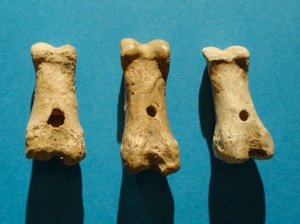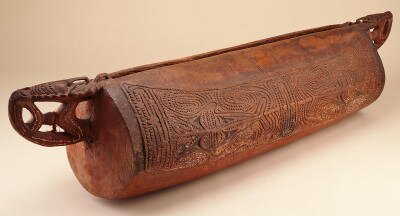5 of the Earliest Musical Instruments ever Discovered

It’s hard to trace music on its historical origins. With no physical evidence, you don’t have proof that something existed and if it did, in what form. However, we have instruments as our starting point and historians as our guides on the path of discovering how our ancestors from a far too distant past understood music. Most of the case studies on this subject reveal the fact that the first “songs” that were ever produced only resumed to sounds released by voice or body. Rhythm was afterwards improved when people started to use their nearby environment in order to produce simple songs by using various objects such wood stone or animal bones. Somehow, step by step, simple sounds transformed into more complex songs that required more refined musical instruments. You can analyze some of them in the following examples:
The oldest musical instrument in the world
….(or so it is said). It has over 43,000 years old and it dates back to the Neanderthal period. It was discovered in 1995 in the Divje Babe cave from Slovenia and its origins are given by the way in which the instrument is structured. Using a cave bear femur as a base, the flute is pierced by four (of which two are visible today) spaced holes. Their alignment were a certainty for researchers that the priceless objected was a Neanderthal flute. Even though we don’t know how the songs of the Neanderthals sounded, we can imagine the sounds it might have produced:
The Hohle Fels Flute
This musical wonder was discovered in 2008 in the Hohle Fels cave, Germany and it has over 35,000 years old. Compared to the previous musical instrument, this one is made from a vulture’s wing bone and perforated with five finger holes. The choice for bird bones isn’t at all strange as it was easier to carve holes in a bone that was already hollow than in a solid ivory. This 22 cm instrument was capable of producing quite complex melodies and was usually used at recreational or religious events. It sounded something like this:
The bullroarer
At a first glance, it is hard to presume that this object was used to produce music. Also known as the rhombus or the turndun, this ancient ritual musical instrument was also used to communicate over extended distances. This instrument was specific to the Paleolithic period and the oldest example of this kind was discovered in Ukraine, dating back to the 17,000 B.C. Generally speaking, this instrument was made of a thin slat of wood with curved edges for aerodynamic purposes. Having a cord attached to it, the bullroarer was given an initial twist and then swung in a large circle. This movement used to cause a vibrato sound something like this:
Phalangeal whistles
These objects weren’t actually musical instruments as they were also used with other non-artistic purposes. For instance, these little pieces of pierced phalanges were also used during hunting sessions as decoys or, on the contrary, as a mean of communication between hunting partners. The sound of this instrument was sharp and powerful and it was usually made from a reindeer’s phalangeal bones.
The slit drum
The slit drum is a hollow percussion instrument made from a carved bamboo or wood with one or two slits in the top. If the slit drum was made from a tree log with three slits, they were cut into an “H” shape from acoustical reasons. The ends of the drum were always closed in order to transform the shell into a resonating chamber. The oldest piece of this type of instrument dates back to the 7,500 B.C and it might have sounded like this:










